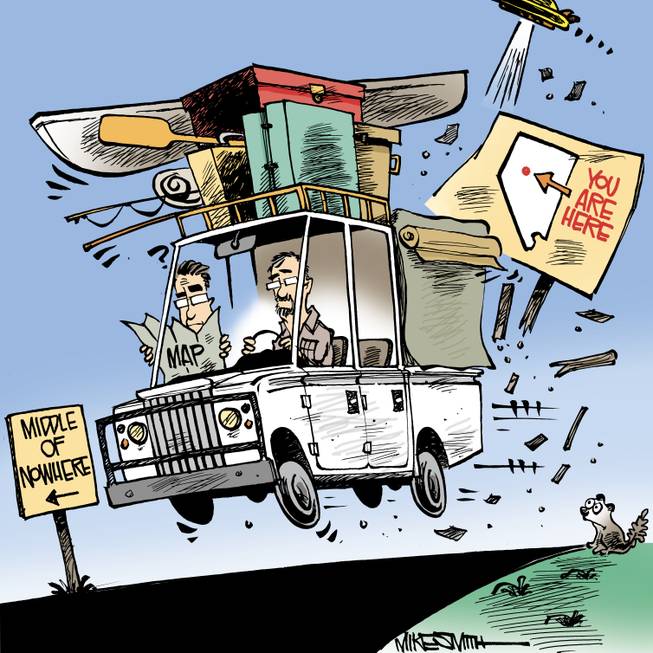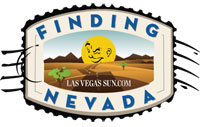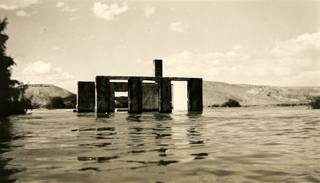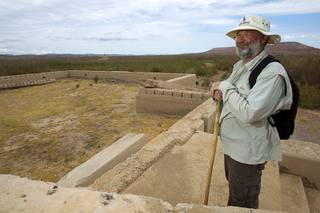Sunday, Sept. 15, 2013 | 2 a.m.
People think they know Nevada, like those national TV figures who stand outside a casino and say things like:
“Tonight in Nuh-VAH-duh, the bright neon lights shine on the glitzy Strip, a boulevard of dreams built by mobsters and risk-taking gamblers ...”
Blah, blah, blah. Clichés and stereotypes.
But then, how would you describe Nevada to someone who doesn’t live here? It’s not that easy, is it?
Nevada is a fascinating, if not quirky, place, much more nuanced — and colorful — than the typical two-dimensional rendition.
Next year, Nevada will celebrate its 150th anniversary, and many of us don’t often see the richness of our state. So, to gear up for the party, editorial cartoonist Mike Smith and I are going on a series of road trips. Our objective: to explore the landscape, discover the places and meet the people who distinguish Nevada. We’re calling our journey “Finding Nevada,” and we want you to join us.
Don’t expect a monologue or a boring history lesson. This will be two guys on the road, talking to people, taking pictures, making videos and drawing sketches and cartoons. And we’ll post our stuff in real time on our website, www.lasvegassun.com/findingnevada.
As we wander the state looking for the people and places that help define and explain Nevada, we’d like your help. Follow the website, watch us on Twitter (#findingnv) and on Facebook, and let us know your thoughts and recommendations. Who should we talk to? Where should we go? Where should we eat?
We’ve heard stories about fantastic little spots that we plan on visiting — the gem of a café in tiny Baker, a top-notch Mexican restaurant in Winnemucca and an antiques store in Ash Springs with the alluring name Wild Rose Junktiques, to name three. And we may knock on the front door of the Governor’s Mansion to see if we’re not too grungy to be invited inside.
We’ll consider all suggestions and invitations from anywhere in the state.
You can weigh in another way, too: We’d love to hear about your own Nevada experiences. We’ll post your stories and photos over the course of the next year. You can send your ideas, tips, stories and photos to [email protected].
So, come along from the vantage point of your desktop computer, your tablet or your smartphone. The view will be great and the company quite pleasant.
Mike and I hit the road this morning.
•••
For me, this journey has to start in St. Thomas, the town best known for being swallowed by Lake Mead.
The ruins of St. Thomas, about 50 miles northeast of downtown Las Vegas, were exposed a little more than a decade ago as the drought sent the lake in retreat. If you want to understand Nevada, St. Thomas is a good place to begin.
Mormon missionaries, sent by Brigham Young to grow cotton and establish a trade route to California, founded St. Thomas on Jan. 8, 1865, a little more than two months after Nevada was granted statehood. Over the decades, pioneers, outlaws, American Indians and migrants tried diligently to scratch a living out of the desert.
Although it was on the route from Los Angeles to Salt Lake City, the town never fully blossomed, and eventually, it would find itself passed by in the 20th century. A nearby copper mine went bust, a new highway was built to the north, and then came Hoover Dam, condemning St. Thomas. The town held on until 1938, when residents left and the waters of the newly formed Lake Mead covered it.
St. Thomas was sacrificed in the name of progress, given up for something better — the promised benefits of Hoover Dam and Lake Mead.
That, in a nutshell, is the story of Nevada: For more than 150 years, people have rushed here to seek opportunity. They stick around until a bust or a better deal drives them elsewhere.
The state map shows the story. There are places with names like Rhyolite and Dinner Station that once thrived but now are abandoned. In its 1940 guide to Nevada, the Works Progress wrote:
“The State is dotted with deserted public buildings, their window panes broken, the paint peeling from their doors — all monuments to public-spirited people whose zeal survived the wrecking of their plans. Though unable to take their plants with them ... they themselves could and did move on to the new camps and start their work over again.”
•••
Today, you can find what remains of St. Thomas in the midst of a dense tamarisk forest in the Lake Mead National Recreation Area. In a place where a few hundred people once lived, there is a collection of bleached foundations, cisterns and irrigation works. There are some remnants of dishes, bottles and metal, but mostly this place was disassembled by the residents and carted to higher ground in advance of the rising water. And then they started over.
But the lack of any dramatic remains — the leaning wooden shacks and rusting industrial works that highlight other ghost towns — hasn’t deterred visitors. Park Service archaeologists routinely encounter people at the site.
Archaeologist Glendee Ane Osborne called St. Thomas “a living memory.”
“There’s a deep emotional connection to these places,” Osborne said. “They teach people about themselves. … It’s human curiosity: Why were you in this inhospitable place?”
Why, indeed.
The Mormon pioneers were sent to St. Thomas to grow cotton and forge a trade route to California. The town was upstream from the Colorado River near the confluence of the Muddy and Virgin rivers, which provided water year-round.
Wandering among the ruins, I couldn’t help wonder what the early settlers were thinking when they came here 150 years ago. It was desolate and hot, and the journey was rigorous. Today, it’s still desolate and hot, but you can cruise into the Moapa Valley on Highway 169, off Interstate 15, with the air conditioning cranked up. The ruggedness of the journey to St. Thomas has been reduced to a dirt road and a half-mile hike to the old town site.
Historian Aaron McArthur, author of the soon-to-be-published book, “St. Thomas, Nevada: A History Uncovered,” writes that a journey down the Virgin River gorge could require more than 30 water crossings. Some people saw their possessions swept away. Others found their wagons stuck in a quicksand-like mud.
And once in St. Thomas, named for one of the leaders of the founding party, Thomas Sassen Smith, the settlers faced searing heat, wind, sand, snakes, scorpions and a swamp filled with malaria-carrying mosquitoes. One commentator said the Mormons would “bake (on) the days (they) didn’t shake” from malaria.
A Utah newspaper reportedly called the area “a Siberia for troublemakers from better lands in the north,” and with the various difficulties, some visitors compared the area to hell.
•••
Still, people came. The Mormons initially came as part of a religious calling. Some non-Mormons saw jobs and economic opportunity in nearby mines or farming. Others, including outlaws and polygamists, would find in St. Thomas a place to lay low and try again.
Regardless of why they came, this piece of the Nevada desert provided a fresh opportunity. And then the town gave way to another destiny.
And doesn’t that sound like today’s Nevada? People still come for work or a second chance or a new venture, trying to create something where they had nothing. When it works, it can work big. Witness Las Vegas and the Strip. If it doesn’t work, you can always move on or start over and implode the past.
This is the Nevada story I’ve come to know, generations of pioneers seeking opportunity. Over the next year, I’m sure we’ll see more of that, and we’ll see what else there is to find.
See the project home page at: www.lasvegassun.com/findingnevada. On Twitter, follow Matt Hufman @mattatthesun and Mike Smith @smithtoons. On Facebook, www.facebook.com/lasvegassun.

 Follow along as the Sun explores and defines Nevada
Follow along as the Sun explores and defines Nevada


Join the Discussion:
Check this out for a full explanation of our conversion to the LiveFyre commenting system and instructions on how to sign up for an account.
Full comments policy